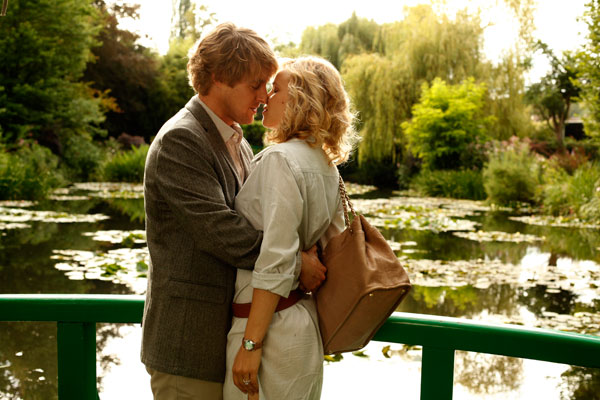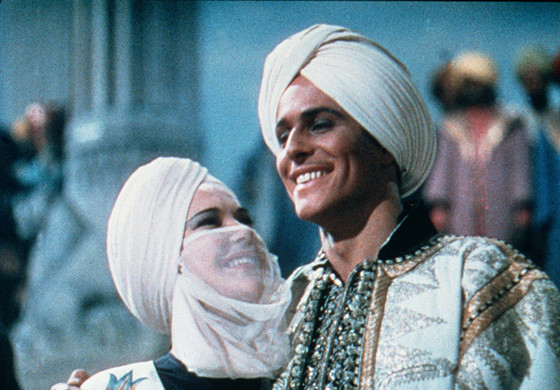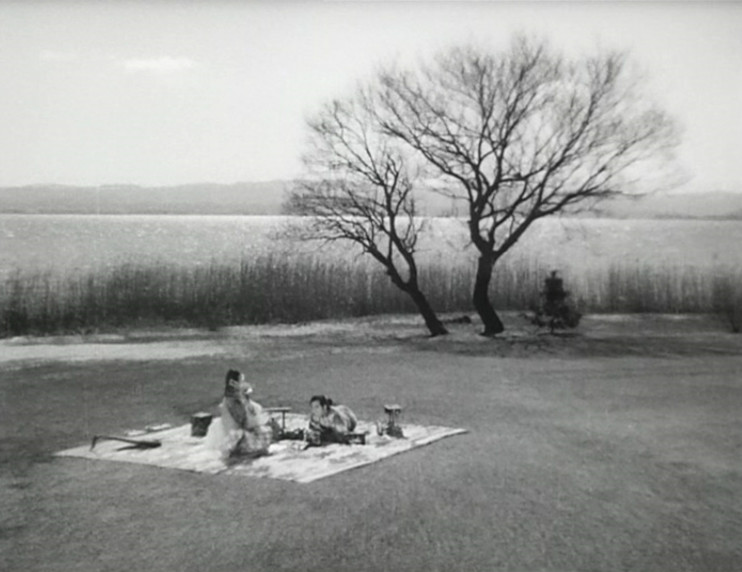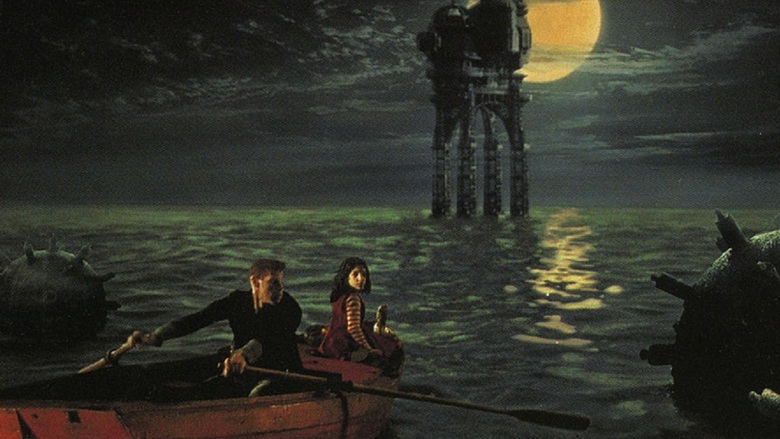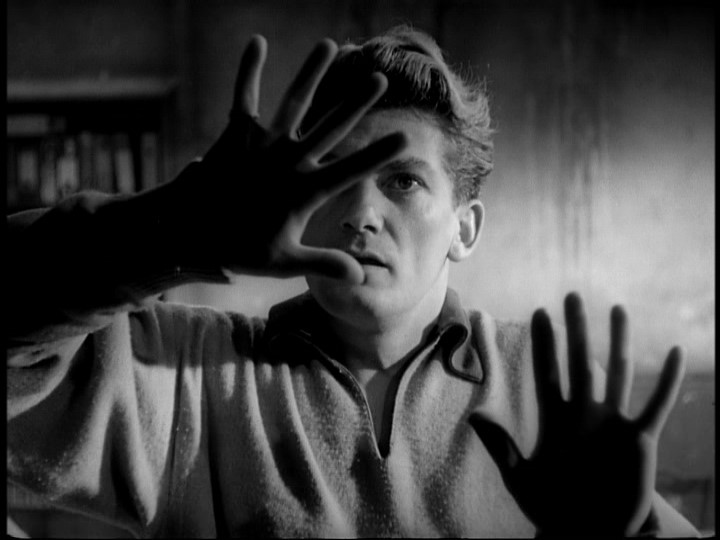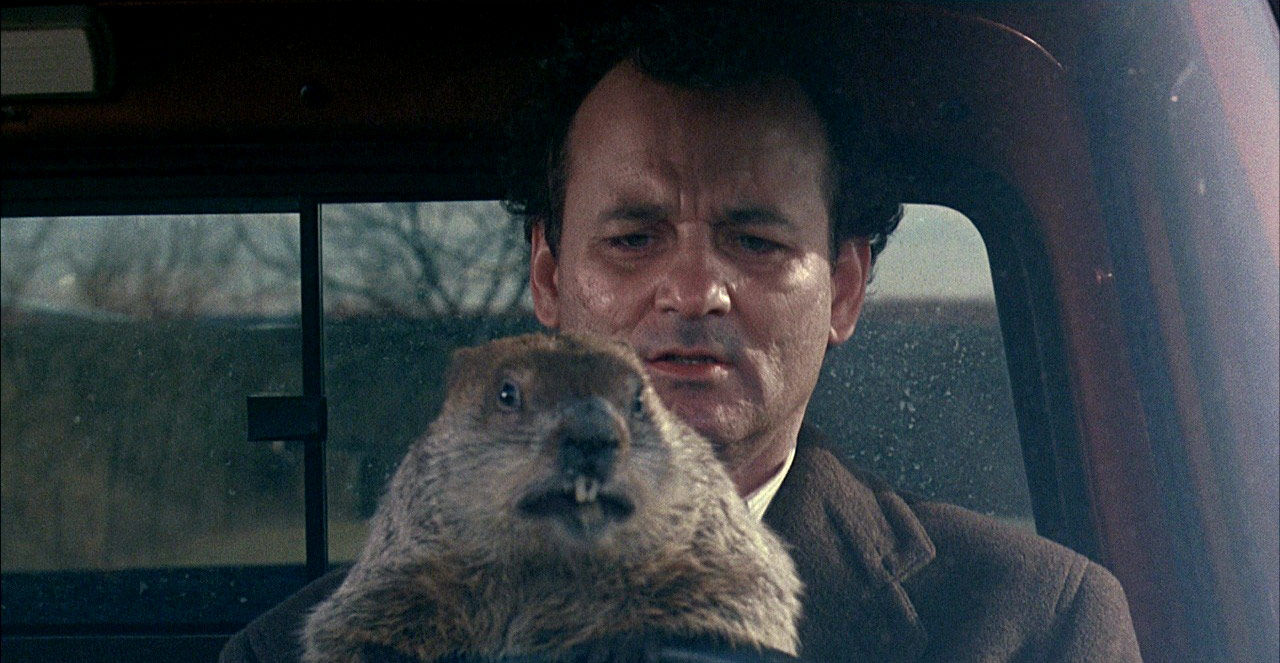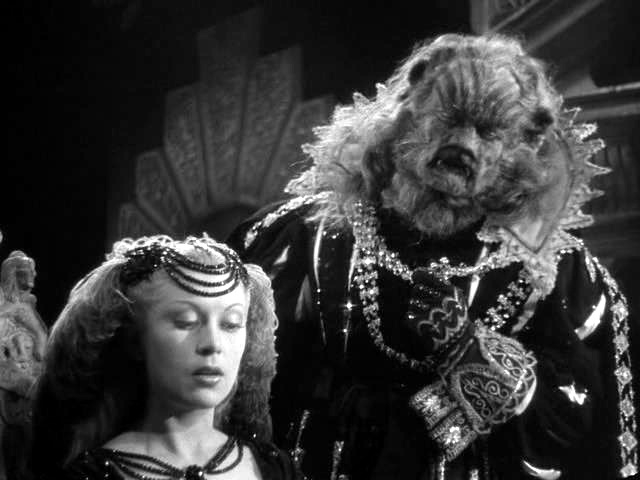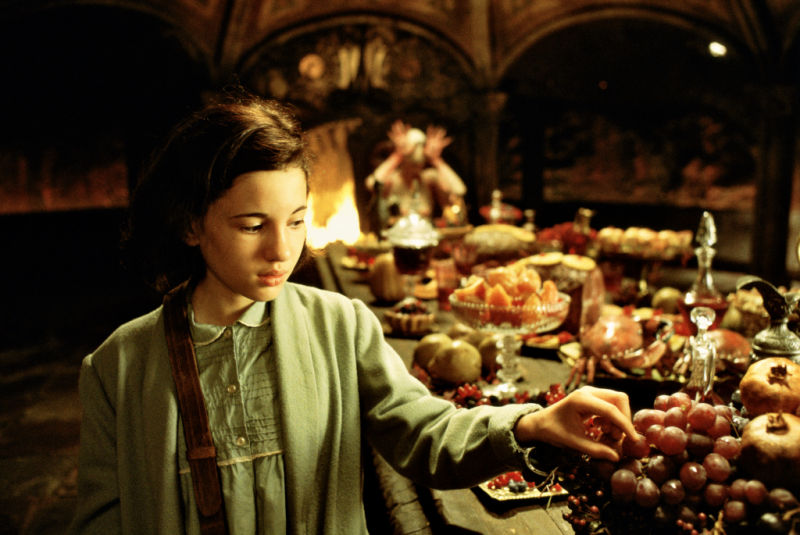8. Midnight in Paris (2011)
Although Woody Allen may be best known for creating films about neurotic upper class New Yorkers, he has also made several films with strong fantasy elements. Thus, the sparkling fantasy,Midnight in Paris, his biggest all around hit in years, shouldn’t be a surprise.
Gilbert Pender (Owen Wilson) is a budding writer visiting Paris with his shallow, materialistic fiancée and her overbearing family. He longs for another, more romantic time and a magical taxi from the 1920s appears to take him back and forth to the Paris of that decade.
There he meets such people as F. Scott and Zelda Fitzgerald, Ernest Hemingway, Salvador Dali, and Gertrude Stein (Kathy Bates)–who becomes his editor! He also meets and falls in love with the enchanting Adrianna (Marion Cotillard), a mistress of Picasso. However, he soon realizes that the past is just a pleasant escape from the reality of the present, especially after Adrianna takes him with her on her own escape fantasy, back to the Belle Epoque.
The special effects are no more than period sets and costumes but the overall effect is delightful. Allen demonstrates that nostalgia is just a sentimental reaction to the unhappiness of the present, romanticizing an earlier time the world managed to survive. However, Gilbert sees a fair share of unhappiness in the past and realizes that the present is what anyone is given and making the most of it is the best human beings can do.
7. The Thief of Bagdad (1924/1940)
The cinema is a large enough canvas to contain two classic fantasies with the title of The Thief of Bagdad, one a lavish silent and the other also a lavish film made just as Europe was going to war. The one is not a remake of the other. They don’t have similar story lines but do have one big thing in common: they were both designed by the great visual artist William Cameron Menzies. Menzies was such a great artist that he could create two ancient Bagdads, which were supposedly set in roughly the same era, and yet have them come out quite differently.
The original featured Douglas Fairbanks athletically venturing through a variety of mythological challenges (such as capturing a flying horse) in order to win the hands of a lovely princess under the director of action specialist Raoul Walsh. For this spare no expense production Menzies created a stunning art deco Bagdad inspired by the art of the superb designer Erte.
In 1940, at the behest of producer Alexander Korda, he supplied an Art Moderne Bagdad in vibrant color as John Justin and Sabu seek to free lovely June Duprez from the grip of evil wizard Conrad Viedt. Again there is a flying horse, a deadly mechanical doll, an enchanted diamond guarded by a savage green tribe, and a genie (Rex Ingram), who sports a southern American accent since the war caused the filming to shift location from Britain to Arizona.
The film had three credited directors (one being Michael Powell) and three unaccredited ones along the way. That many directorial voices should have resulted in a mess but Menzies’ story boards tied it all together and this film joined the silent version as one of the great and most beloved films of its genre.
6. Ugetsu Monogatari (1953)
The Japanese have always seemed to take tales of the supernaturalseriously. Ugetsu Monogatari is a ghost story for adults and was one of the first great Japanese films to find international success.
Set in 16th century Japan, during one of those civil wars which always seem to be taking place in Japanese period films, two families are living side by side in the obscurity and relative safety of the country.
A wise man tells the husbands to refrain from seeking wealth and status during so turbulent a time, But one husband wishes to use the pottery he makes as a stepping stone to becoming a great artist and the other wishes to become a samurai. The men seek their goals at great costs to their families, falling under the spell of a spectral noble woman who pulls them into a dimension at odds with the real world.
This is truly fantasy used as a vehicle to make a greater point. The much acclaimed director Kenji Mizoguchi wanted to comment on war and how the innocent people who are otherwise unconcerned about the causes of war are always caught in the middle and suffer as a result.
Due to the director’s great care and skill the atmosphere of the film is plausible as both a realistic drama and as a fantasia of spirits inhabiting a real world and investing in the concerns left behind when death took them. Mizoguchi was given a large budget and virtually total freedom . Again a skilled cinematographer helps immeasurably thanks to Kazuo Miyagawa’s convincing marriage of dreamlike and realistic images.
5. The City of Lost Children (1995)
If there is any living director capable of creating fairy tale films for adults then it is surely another French film maker, Jean-Pierre Jeunet. His films are the cinematic equivalent of the devices created on paper by illustrator Rube Goldberg: absurdly complicated, messy, wild, imaginative and ultimately workable. Delicatessen and Amelie have many fans but perhaps his most fantastic effort is The City of Lost Children.
The story has a deranged scientist living on the most idiosyncratic oil rig of all time in the middle of the ocean kidnapping children and keeping them captive. Why? Well, he can’t dream so he’s created a device to steal the children’s dreams! And, apparently only children’s dreams will do.
The story has a brave, strong man, a cult of children who live as thieves, clones, conjoined twins, kidnappers dressed as Santa and many other wild and wondrous sights. Relating the plot makes it sound ridiculous but it doesn’t play that way. In fact, the film, like the director’s other works, feels fresh and original and highly inventive. These are darker and more complicated days so maybe fairy tales for modern times must be as well.
4. Orpheus (1949)
After the triumph of Beauty and the Beast Jean Cocteau tried his hand at two other films before returning to a more fantastic subject when he decided to indulge in his continuing obsession of to film the ancient myth of Orpheus. Cocteau had drawn from this story when he created his first film, the famous short, The Blood of a Poet (1930), and would revisit it again at the end of his career with The Testament of Orpheus (1959). However, the version he would create in 1949 would stand as one of his monuments.
As in the myth, Orpheus (Jean Marais) is a gifted poet, but not a popular one. While in a café, he crosses paths with an exquisite but mysterious princess (Maria Casares) and the popular young poet (Edouard Dermithe) she is sponsoring. The young man is drunk and during a fight he provokes he is run over and killed by phantom cyclists as he stumbles into the street.
The princess has him put in her car and beckons Orpheus to join her. She takes him on a long journey to her castle where she proceeds to bring the young man back to a form of life! It seems that she’s death itself and is quite intrigued with Orpheus. The poet finds that he can enter her world via mirrors and that this life/death zone has a logic of its own. Unfortunately, he starts to neglect his loving wife, Eurydice (Marie Dea), which leads to a tragedy bringing him into conflict with the princess.
Few films can claim to truly capture the feel and syntax of a dream but Orpheus is among that few. It is also one of the most stunning of dreams.It is a about a myth but it’s a also about Cocteau as well. It is obvious to me that he identified with Orpheus and that this tale of a poet staying true to himself and battling eternal matters was essential to the film maker, thus creating a highly personal fantasy.
3. Groundhog Day (1993)
Every once in a while a film comes along which is simply better than expected. The team of director Harold Ramis and actor Bill Murray worked together several times but the clever and inventive fantasy, Groundhog Day, would prove to be their most enduring work.
Murray plays a snide, self centered TV weatherman who is going through his yearly motions of reporting the annual Groundhog Day celebration in Punxatawney, Pennsylvania. But something goes mightily awry this year. When the anchor wakes up the next day it’s Groundhog Day again. And again the next day..and the next day. Somehow he’s caught up in an endless continuum and is reliving the same day over and over. At first he has fun with it, changing things here and there during the day, but then the reality of being stuck in the same day hits and he gets increasingly desperate.
The director and writers let their imaginations run wild and Murray responds with a peerless comic performance (could anyone make jaded boredom any funnier?). They are supported by a cheerful cast including Andie McDowell, Chris Elliott, and Steven Tabolosky. Somehow the magic just happened for this film and it transcended what could have been an ordinary commercial framework.
2. Beauty and the Beast (1946)
Was there ever a film maker quite like France’s Jean Cocteau? To call him just a film maker would be slighting him . He wrote prose , poetry and plays, painted, designed, and directed on both stage and film. Although he only directed a few films, one of the most memorable is one which shows how much of a child still lives in most adults.
Most readers are familiar with Beauty and the Beast. In this classic story, Belle (“Beauty” in French) in sent to live with an enchanted beast in his majestic, if gloomy, castle in order to save her father. What she doesn’t know is that the Beast is under a spell which can only be broken if he wins her love. Simply put it’s a very primal tale, but open to more complex interpretation.
It might sound too basic for someone as accomplished as Cocteau and surely not something an adult would watch with any interest but how wrong those conceptions would be! Cocteau had a rare gift for invoking mysticism, magic, and enchantment in his work. It’s obvious that he was deeply in touch with both his inner child and outer artist.
With only the simplest of means at his disposal (post war France didn’t have an abundance of materials with which to work) the director easily made cinematic magic. Not the least of which included evoking the wondrous period settings and the fantastic realm of the Beast’s castle. Even when one knows how the tricks are accomplished they are still superb.
It doesn’t hurt that Belle is the ultra-beautiful Josette Day and the Beast (and Belle’s suitor and a prince at the conclusion) are played by Cocteau’s ever so handsome significant other Jean Marais. Not that they are dressed up in one of the most stupendous jobs of black and white cinematography ever filmed, courtesy of Henri Alekan. Anyone who claims to be too old for this one isn’t worth knowing.
1. Pan’s Labyrinth (2006)
One of the biggest surprises of the 21st century’s first decade was an expertly made dramatic fantasy from Mexico by a director,Guillermo del Toro, who had never before created a major film.
The story is set in the early days of the Spanish Civil War and concerns a young girl named Ofelia (Ivana Baquero) who is in an uncomfortable situation. Ofelia’s mother is newly married to an army officer who is ruthlessly hunting down anti-fascist partisans while Ofelia’s pregnant mother is becoming increasingly ill. The girl’s bleak existence is broken by a host of magical creatures such as fairies and mystical fauns who draw her into an abandoned garden maze.
The film is a tour-de-force of both realistic drama and imaginative magical adventure. It’s obvious that the story is a fable concerning the triumph of the human spirit, if only in the richness of dreams and fantasies even in the worst of circumstances. The film tells a sad tale yet feels triumphant. Though de Toro is as distinctive as any director working currently in films, he also has created a deeply moving human document.
Author Bio: Woodson Hughes is a long-time librarian and an even longer time student/fan of film,cinema and movies. He has supervised and been publicist for three different film socieities over the years. He is married to the lovely Natalie Holden-Hughes, his eternal inspiration and wife of nearly four years.”
